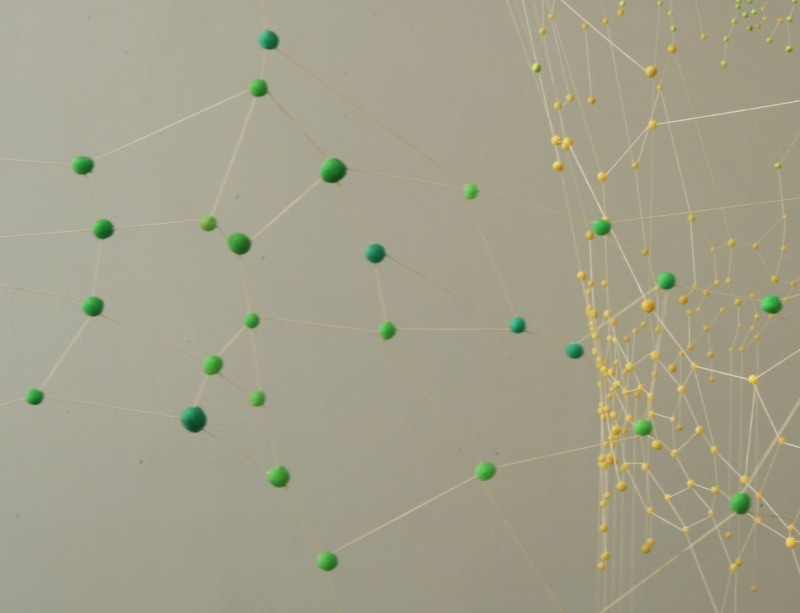
“Freeing the Line” is the name curator Catherine de Zegher has selected for her latest group show. But surveying the impressive exhibition, an alternative title springs to mind: “Line of Flight,” a term culled from the lexicon of revolutionary French philosopher Gilles Deleuze. Referring to a means of resisting the status quo, a “line of flight” is less an exit route—a way to escape an oppressive system—than a loose thread. When picked, it unravels, and thereby transforms, the very fabric of which it is part.
In this case, the fabric is the medium of drawing as traditionally defined—a picture composed of lines inscribed on a two‐dimensional paper support. The “line of flight” that the show delineates is nothing other than line itself, “released into space,” as de Zegher’s curatorial statement puts it.
De Zegher takes as her starting point the “drawings without paper” that Venezuelan artist Gego (Gertrude Goldschmidt) began making in the 1970s, two of which grace Marian Goodman’s front gallery. Composed of aluminum rods and bent metal wires, these abstract tableaux trace themselves in shadow on the walls behind them, effectively blurring distinctions between sculptural objects and graphic image, work and the world. The front gallery also prominently displays several hanging constructions from the mid‐’70s by 82‐year‐old Czech artist Karel Malich. As in Gego’s paperless drawings, Malich’s works take the room as their ground in lieu of paper. They seem at once coiling volumes and—to borrow a description from critic Christian Kravagna—“drawings floating in space.” They also seem oddly both languid and tense; dispersed compositions bleed into the environment, yet can barely contain their kinetic energy.
Like Eva Hesse, who presides over the show’s back gallery, Gego and Malich belong to a late‐’60s generation of artists who, despite far‐flung locales, were united in their resistance to geometric abstraction, with its rational, repeatable structures and idealized forms. De Zegher complements the historical works with offerings by a like-minded and similarly international group of young artists. Malich'a restless spirals and Hesse's tangled skeins are echoed in the delicately unfurling expanse of Vasanta - a vast network of threads connected by colored wax pellets, created by Bangalore-based Ranjani Shettar. Belgian Joelle Tuerlinckx crafts open cubes from hand‐painted wire that sag and bend in quiet defiance of geometric order. Monika Grzymala, from Germany, takes up Hesse’s obsessive working methods and violent undercurrents in a commanding “room drawing,” composed of miles of black and white masking tape that overtakes one corner of the back gallery, wrapping over a column, pooling in a tangled mass in a corner and then jutting back into the room and across a window in a final burst of energetic force.
Advancing aesthetic concerns she first developed while the director and chief curator of the Drawing Center (and featuring a number of artists shown there under her aegis), the exhibition also clearly functions as de Zegher’s own “line of flight” out of that institution. She resigned in March in the wake of a controversy ignited by her refusal to bow to Governor Pataki’s implicit demand for self‐censorship on the part of the organizations (the Drawing Center among them) chosen to occupy the cultural complex being built at Ground Zero. De Zegher’s first curatorial effort since her resignation, “Freeing the Line,” redefines drawing by turning it inside out. But it also hews to at least one of the medium’s most traditional roles: to provide a place where ideas can be rapidly formulated, easily tested and playfully explored. While elegantly structured and eminently satisfying in its own right, de Zegher’s show serves as a kind of preliminary sketch—the tantalizing first thoughts for a larger, more comprehensive exhibition hopefully soon to come.
-Margaret Sundell